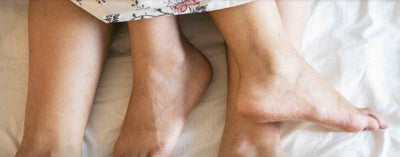| Caroline
Pudendal Neuralgia Symptoms and Causes
Pudendal neuralgia symptoms can be painful and worrying, so should be diagnosed quickly. Find out more about pudendal neuralgia, its symptoms and causes...
The pudendal nerve is probably not something you’re aware you have until you develop a problem with it. The nerve runs from the lower back, along the muscles of the pelvic floor and into the perineum (the area between the anus and the scrotum or vulva). If you’re feeling pain in this area, possibly during sexual intercourse as well, you may have pudendal neuralgia. Pudendal neuralgia symptoms can be quite unpleasant, but don’t worry… there are things you can do about it.
Pudendal nerve entrapment is a recognized cause of chronic perineal pain [1, 2], typically presenting as pain in the penis, scrotum, labia, perineum, or anorectal region. Pudendal nerve entrapment is a clinical diagnosis made in patients with the typical history of perineal pain aggravated by sitting, relieved by standing, and absent when recumbent or sitting on a toilet seat. No widely accepted confirmatory test is available, although a neurophysiologic examination may confirm nerve damage.
The term pudendal neuralgia refers to chronic pain around the pudendal nerve. To get a clearer picture of how this happens, it may help to consider how nerves function. Nerves can actually stretch quite easily, and they can also be squashed. That’s how we get those ‘pins and needles’ feelings when we’ve crossed our legs for too long or slept awkwardly on an arm. Fortunately, nerves bounce back pretty quickly most of the time so these sensations are short-lived.
However, there are times when we may accidentally traumatize a nerve. For example, we might have a nasty fall. We might also traumatize our nerves through repetitive movements that result in wear and tear (such as typing, or certain kinds of exercise).
Pudendal neuralgia symptoms
When your nervous system becomes sensitized to this kind of pain, the pain response is greater and can be triggered more easily. When this happens to the pudendal nerve you may experience a number of different pudendal neuralgia symptoms.
Pain is the most common symptom of pudendal neuralgia, but the sensations can vary greatly from person to person, as can the intensity. Typical pain sensations range from:
- Burning sensations
- Aching
- Shooting pains
- Itching
- Over sensitivity
Both sexes experience these kinds of pain, but for women it is usually centered around the clitoris, labia, and/or vagina. It can also be felt in the urethra, anus or perineum.
Other areas susceptible to pudendal neuralgia symptoms
Pudendal neuralgia symptoms can occur in other areas around the pelvic region too. For example, irritation or pain may be felt in:
- The bowel
- The bladder
- The buttocks
- The legs
- The feet
It might be surprising to hear that you can feel this pain in your feet, legs and buttocks, but this is a referred pain. It happens because the skin in these areas is supplied by the same area of the spine, so your brain can interpret the pain as having come from there.
Causes of pundendal neuralgia
Pudendal neuralgia can happen because the pudendal nerve is somehow traumatized. Here are some of the more common pudendal neuralgia causes:
- Difficult childbirth
- Pelvic or perineal injury or trauma
- Surgery in the pelvic area
- Straining due to constipation
- Poor posture
- Too much exercise (e.g. cycling or horse riding)
- Stress
Your pudendal neuralgia symptoms may also be down to nerve compression; for instance, you might have large pelvic floor muscles or tight ligaments – both can cause compression of the nerve. Sometimes there is more than one reason for pudendal neuralgia, and it may be difficult to pinpoint them.
Note that the symptoms of pudendal neuralgia may feel a lot like the symptoms of vulvodynia, another pain condition in the vulva. Your Doctor should be able to differentiate between this and pudendal neuralgia.
However, both conditions can lead to sexual problems and difficulties in sitting comfortably, so if you are experiencing what seems to be pudendal neuralgia symptoms, it is important to get them checked out so that you can start treating the problem. We will shortly be covering pudendal neuralgia treatment options, so don’t forget to follow our blog for further information on this subject.
End of article.
Vaginal Dilator therapy helps improve pelvic health and female sexuality. They are used to help a wide variety of female health concerns. Speak to your doctor today about how dilator therapy can help you.
Do you need to order vaginal dilators so you can start your pelvic floor therapy process? Made in the USA. Visit www.vuvatech.com
VuVa Dilator Company Helpful Links:
How do Neodymium Vaginal Dilators work?
7 Reasons for a Tight Vagina and How to Loosen
How to Relax Vaginal Muscles, Vaginismus & Sex
Vaginal Stretching - Keeping in Shape with Dilators
Do Dilators Really Work? Yes, and They can Improve Your Sex Life!
Shop for VuVa Vaginal Dilators
Tara Langdale Schmidt is the inventor of the VuVa Dilator Company. She has pelvic floor dysfunction herself and wanted to create a dilator set that is made in America that women can trust. VuVatech has been in business since 2014 and has helped over 50,000 women all over the globe. She patented the Neodymium Vaginal Dilator, that is clinically proven to help with blood flow and nerve pain.














